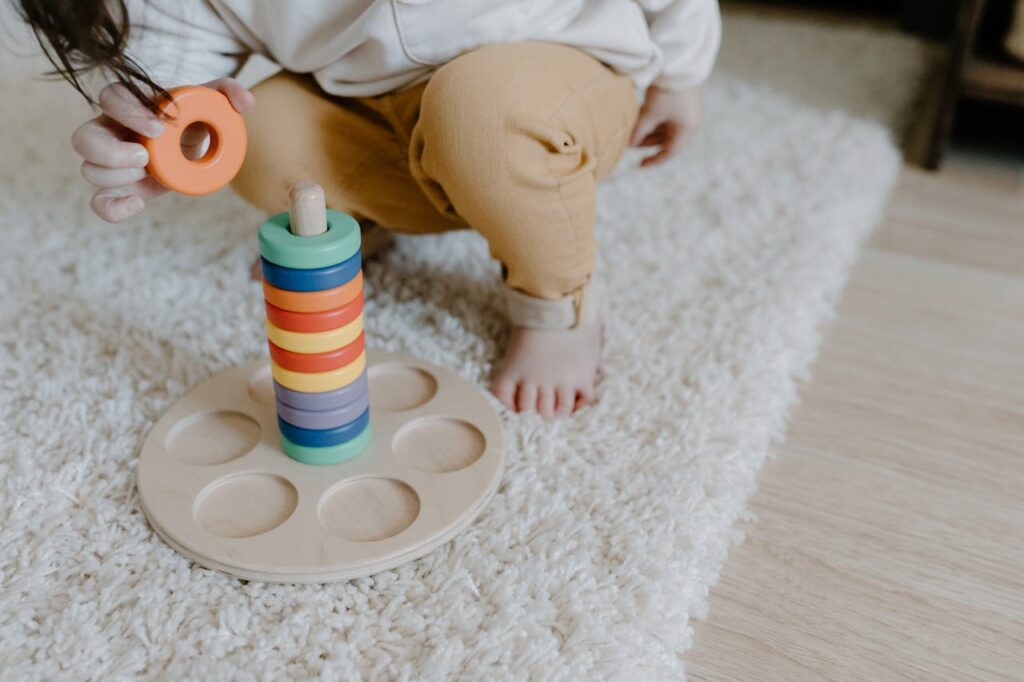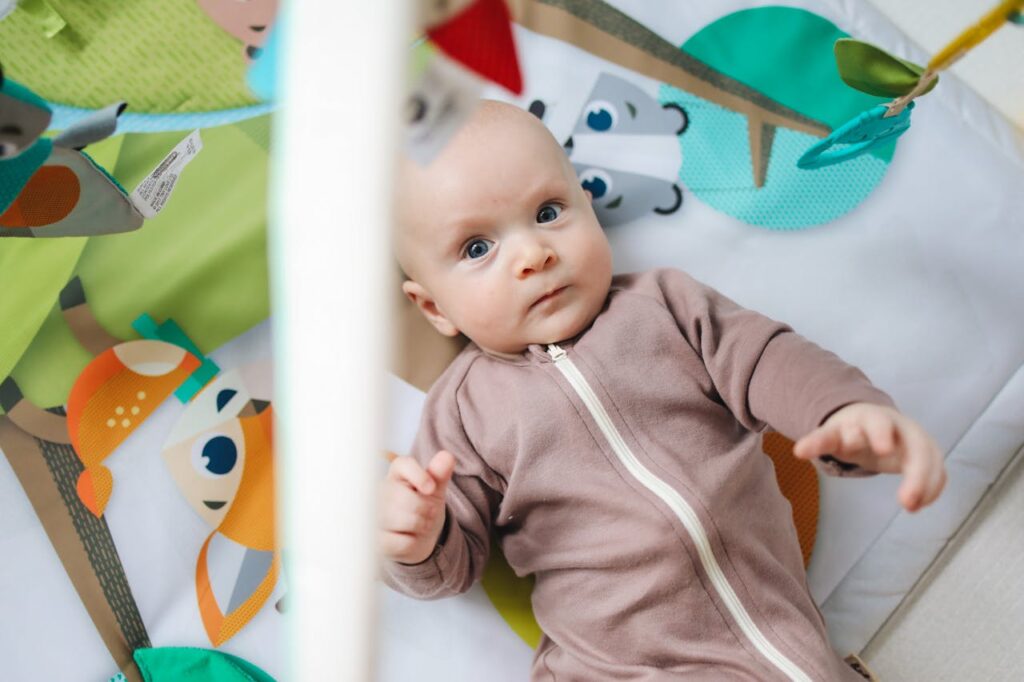Talking is one of the biggest milestones new parents anticipate in the first year of life. Every baby will move at their own pace to achieve this milestone. Engaging with your little one in daily routines is a great way to stimulate language development. Through the simple everyday acts of talking, singing, and reading, your baby will be 10 steps closer to building the necessary communication skills.
I promise you it is just that simple.
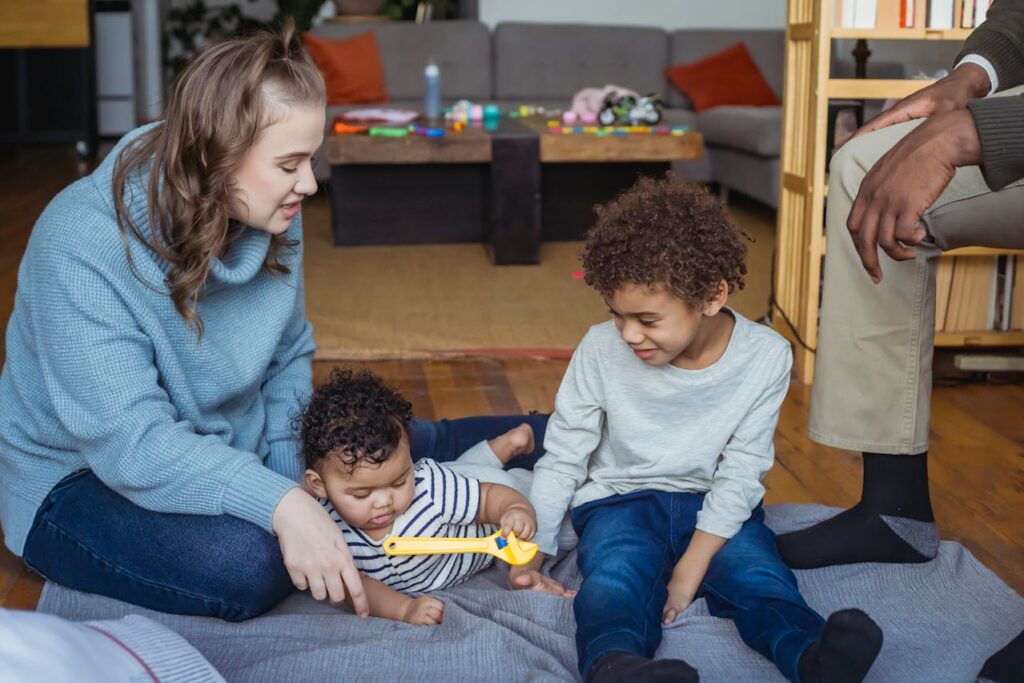
Why do language development activities in the first year of life?
From the time your baby has been in the womb, your baby has been able to hear you talk. When they are born they start by making eye contact, smiling, babbling, cooing and of course crying. Crying is seen as the first means by which babies communicate. Through crying your baby can communicate their thoughts, feelings, and needs.
The first year of life is crucial in a baby’s language development as infants absorb a lot of information from their surroundings. Language development not only allows children to express themselves it also plays a significant role in their emotional, social, and cognitive development. Language is everywhere around us. Parents and caregivers play a vital role in fostering language development by intentionally making use of the rich language environment in their daily routines.
By year one, most babies will start talking. But before that, they will have achieved a few milestones which comes from watching how parents and family members respond to them when they coo, cry or squeal. Parents and caregivers can assist children in reaching these milestones by engaging them in language development activities that are not only fun but also effective in enhancing their language skills.
Here are some milestones your little one would’ve achieved by year one!
– Coos, squeals, cries
– Recognize familiar voices
– Respond to those familiar voices by smiling and laughing
– Gestures to communicate her needs
– Respond to instructions such as “Come to mama”
– Adapt different cries for different needs
– Respond to their name
– Recognize the names of common objects around
In this article, I will discuss some of the best language development activities for children that parents can incorporate into their daily routines to support their language development.
Language Development Activities for Infants
Reading Books
Reading aloud to children is one of the most effective ways to foster language development. This activity widens your child’s vocabulary and helps them develop listening, comprehension, and storytelling skills. Parents can start reading to their children as early as in the womb. As the child grows you can gradually increase the complexity of the books and make reading a part of the daily routine. Start by giving them the option of which book to read. Hold up two books and ask the baby which one she wants to read. She will respond by coos or grabbing the book of choice. The best books are usually picture-rich board books with bright contrasting colors, simple words, and repetitive text. Be sure to read by adding funny facial expressions, changing the tone of your voice and a variety of sounds such as vehicle and animal sounds to heighten the activity.
Parents can point out pictures in the book, and give names to objects, animals, and colors. For example “Red Cow” and “The cow goes mooooo”. This will help them make the connection to what they see in their surroundings to what they see in books. During the first year of life, your little one won’t be able to read themselves but give them a chance to explore the books by grasping and turning pages and exploring the texture of the books. This is also a great way to build fine motor skills and hand-eye coordination in your little one. Reading aloud can also create a bonding experience between the parent and child and stimulate curiosity and imagination.
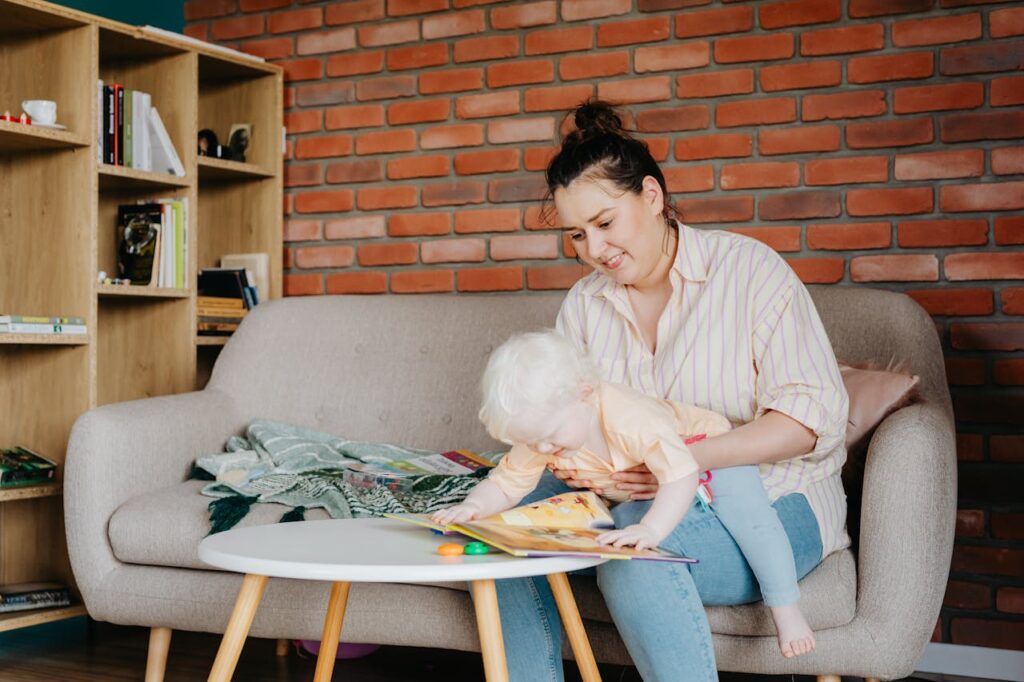
Singing and Rhyming Games
Yes singing! Don’t worry, your baby doesn’t need you to be Mariah Carey. By the time your baby is born, they would’ve gotten used to your voice already. And I’m pretty sure you would’ve sung a tune for them to hear by now. The simple act of singing and rhyming are great opportunities for promoting language development in children. Singing lullabies and nursery rhymes can help children learn new words and reinforce language patterns. You can even create simple songs while performing daily household activities to enhance pronunciation skills. “We wash the cup”, “Spread the bed”, “Wash the clothes”.
Rhyming games can also be a fun way to teach children about word patterns and phonics. These activities can help children develop their phonological awareness and improve their language skills.
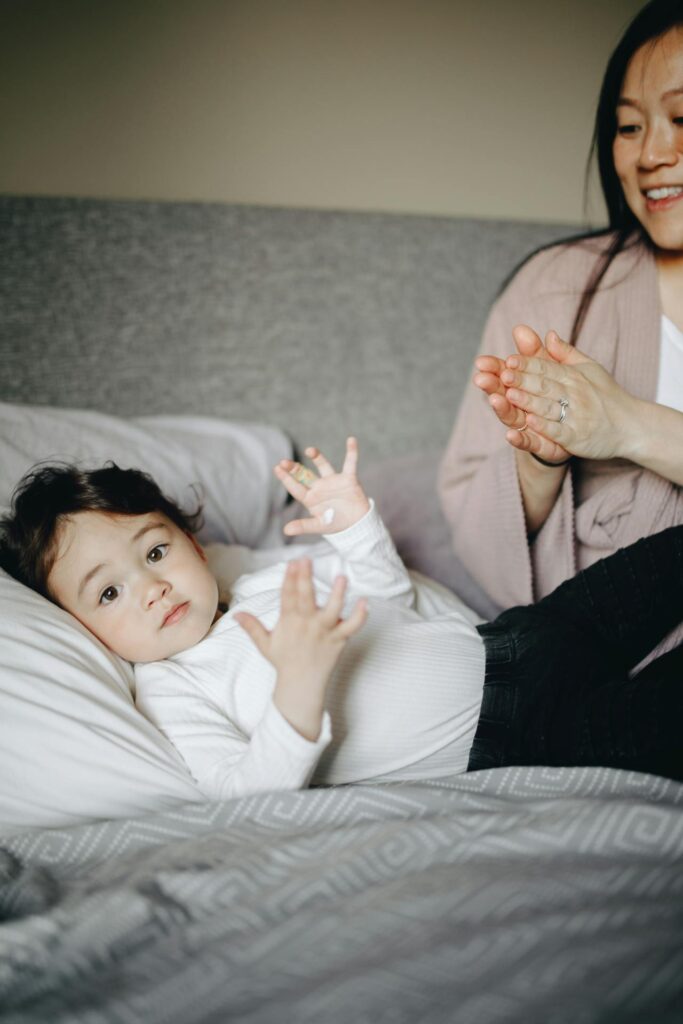
Have a Conversation
Your baby is always engaging with you so why not talk back? Through the coos and cries your little one is trying to get your attention to engage you in conversation. Respond to them in the “parentese” way. Parentese and baby talk are two different styles of communication. The latter uses nonsensical words or phrases to somehow try to talk to babies. While parentese uses real words but in a more expressive and elongated speech in a high-pitched sing-songy voice. For example instead of just saying “Look at the moon” you can say “Loooook mooooon”.
When they coo, cry or squeal respond to them and put into words how your baby is feeling based on the sounds that they make, how they look, and their gestures. For example, “I see that you are hungry”, “You are crying because you want to sleep”. When your little one stretches their arms to you say “I see that you want mommy to pick you up”. When they crawl towards an object you can say “You want to grab your stuffed bear”.
Engaging in conversation with children is a fundamental activity for developing their language and communication skills. Parents can talk to their children about their day, ask about their thoughts and feelings, and listen attentively to their responses. Make the conversations a two-way street. Pause for a response even if it comes in the form of coos, listen, and respond by narrating what it is she might be saying. Conversations provide children with opportunities to practice their speaking and listening skills, learn new words, and express themselves effectively.
Parents can engage children in conversations about their interests, experiences, and observations. They can ask open-ended questions, share their own stories, and encourage children to participate actively in the conversation. Conversations help children build their social skills, develop their cognitive abilities, and strengthen their language development.

Peek-a-boo
The age-old simple game of peek-a-boo builds receptive language skills in the early years of life. During this back-and-forth interaction, you incorporate body movements when you cover and then reveal your face and in time your little one will be able to follow your simple instructions to play along. Additionally, you can further improve your baby’s language skills by hiding their favorite toy underneath or behind objects and narrating the game. In a simple game, you can hide the stuffed dog underneath the blanket and then ask “where is the blue dog?”. Remove the blanket and then say “The blue dog was hiding under the white blanket”.
Check out this post to understand the importance of peek-a-boo and how to play it.

Interactive Bath Time and Diaper Change
Bath time and diaper change don’t have to be another chore. Doing these tasks is one of the best ways to teach your little ones about their body parts. Bath time involves a lot of rich sensory activities such as feeling the warm water touch the skin, the colorful bath toys floating in the tub and of course the bubbles and splashing of water. You can name body parts as you wash your little one so that they can use the correct terminology in the future. Describe the colors and textures of the bath toys and the temperature of the water. Use gestures, different sounds, and silly faces to narrate stories with the bath toys to improve baby language development and make bath time a positive experience.
Diaper change likewise is another mundane everyday activities that can be enriched to build early literacy skills. Due to its repetitive nature, it is one of the best ways for language acquisition in younger children. In the act of changing a diaper there is a lot of eye contact and your face will be very close to your baby’s face so they get a great opportunity to read facial expressions and the movement of your mouth. This will allow them to grasp the context of your words and learn how to form words. Of course you will name body parts during diaper change and name the objects use in the process.

Tummy Time
Tummy time is a great way for babies to explore their environment. While down low they can freely move about to grab and toss the toys around. Toss a ball to your little one while narrating your actions. Babies love to mimic the actions of those around them. “I am using my hands to throw the ball”, “Catch the red ball”, and “Grab the red ball with your hands”.
Get down on the floor during tummy time and face your baby. Touch areas on her face and name the body parts. This is a good idea to help with the recognition and name of body parts. Add to the fun by placing the baby in front of a standing mirror and watching her get excited to see her reflection as she gets used to her body.
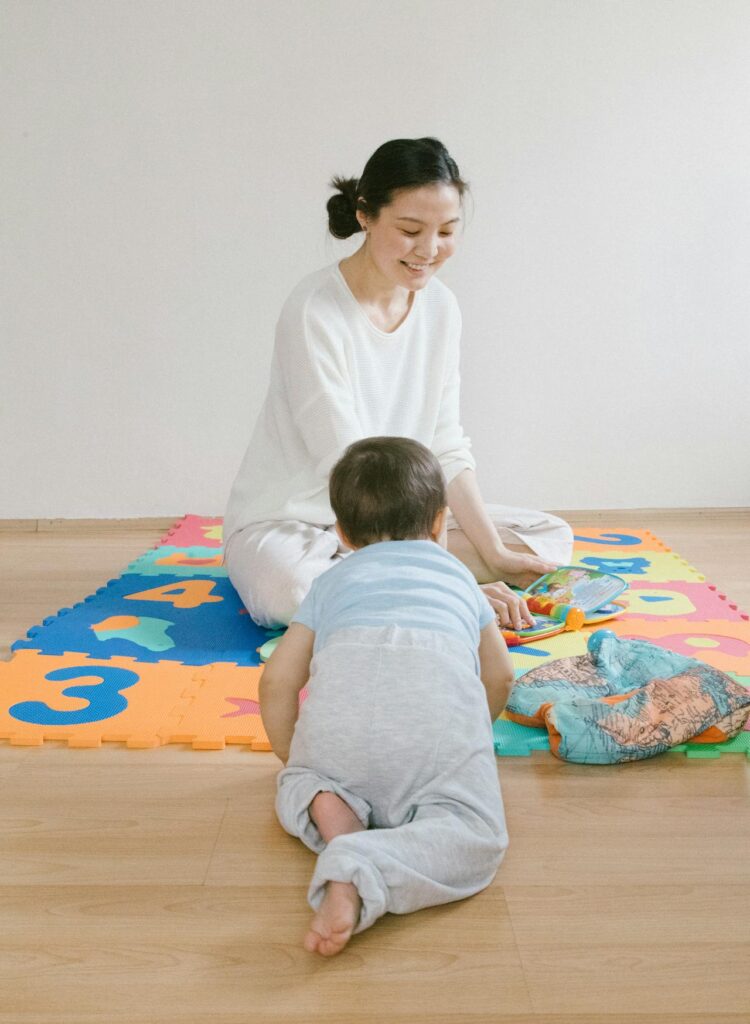
Frequently asked questions:
1. What is an example of language development in infants?
By 6 to 9 months your baby will start to respond to their name. They will also start to understand the context of commonly used phrases like “hello” and “bye-bye”.
2. What are 4 activities that can be used to develop children’s spoken language?
Reading, singing and rhyming, lots of conversations and playing peek-a-boo.
3. How can we help our infants develop language?
Engage them in conversation from a very young age. Respond to their coos, squeals, and cries.
Conclusion
Infants are naturally primed to learn. So parents need to be intentional in doing language activities to build a strong foundation for language learning. These activities highlighted above are a part of your daily routines. Why not enrich these chores and make them into opportunities for language development?
Give your baby a head start, and prepare her for future success by doing these simple at-home activities.
It is important to remember that each child develops at their own pace and milestones indicate the general timeframes during which most children develop. If you have concerns about your child’s speech development, consult an occupational therapist or a speech-language pathologist.

